Film Name: 浪浪山小妖怪 / Nobody
I have always believed that the first episode of last year’s “Yao-Chinese Folktales,” titled “The Little Monster’s Summer,” was not the best (or even among the top episodes), but it was undoubtedly the most popular and widely recognized. This is undeniable, as the episode resonated deeply with a broad audience.
The animated film adaptation of “Nobody” is set to premiere soon. Perhaps because everyone who attended the advance screenings raved about it, leading me to set my expectations too high, I found the film wasn’t as good as I had hoped after watching it. However, it did make me laugh and cry, with a compelling story, meaningful themes, and high production quality—it’s definitely worth watching.

Specifically, the film amplifies the strengths of the short film while expanding its themes, metaphors, and depth, offering richer interpretive space and viewing layers. This allows audiences to not only enjoy the content but also feel empathy and aspiration… However, the film also exposes the narrative limitations of adapting a short film into a feature-length one. The nearly two-hour runtime isn’t entirely smooth, and despite the expanded scope, it loses some of the original lightness.
That said, overall, I’m more than happy to give “Nobody” a positive review. Good animation is never in short supply, and works like this—both refreshingly lighthearted and yet grandly elegant—are exactly what we need.
[Friendly reminder: The following text contains spoilers.]
To be honest, “Nobody” is one of the few animated films I’ve seen that I find difficult to evaluate in terms of its visual presentation. In the past, I would praise films that were visually appealing and distinctive, but otherwise I would skip over them without comment. However, this film falls into the category of “very good, but not quite good enough.”
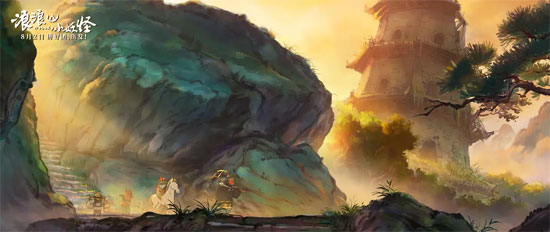
This film was produced by the Shanghai Animation Film Studio. For older Chinese people, the status of the “Shanghai Animation Studio” needs no further explanation. The film’s style is interesting, the backgrounds are beautiful, and the production values are solid. It even gave me a sense of nostalgia, reminiscent of watching cel animation in the past. This alone is enough to praise it.
However, after years of marketization and its own ups and downs, the Shanghai Animation Film Studio is no longer at the forefront of innovation. In “Nobody,” one can sense the limitations in camera usage and the thinness of “small-screen thinking guiding big-screen presentation,” which is indeed a pity.
But my minor criticisms are insignificant. The true reason the film has received so much praise lies in its ability to tell a story that resonates deeply with audiences.
The plot of “Nobody” differs from that of “The Little Monster’s Summer”; it can be seen as another “parallel universe” version of the Journey to the West story: A pig demon from Langlang Mountain is hunted down by the Great King Cave for doing his job too well. He decides to take matters into his own hands, recruiting a toad demon to flee with him, along with a weasel demon and a monkey demon he encounters along the way. Together, they impersonate the Tang Monk and his disciples and set off on their own journey to the West to retrieve the scriptures.
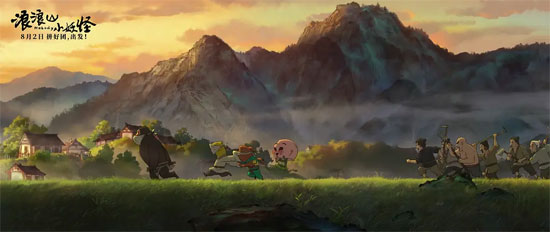
I don’t want to dwell on the film’s symbolic implications regarding the workplace, society, and class, but rather discuss the mature progression of the “little demon’s quest for scriptures” in the story.
In this world, demons are not necessarily stronger than humans. Many powerless little demons fare worse than rural peasants. For example, dog demons are forced to work under the threat of farmers, while weasel demons can only hide behind small village temples to steal offerings… Therefore, for a group of minor demons who couldn’t secure a spot in the demon clan in the mountains and couldn’t make a name for themselves outside the mountains, the absurd and unrealistic idea of impersonating pilgrims actually turned out to be a decent plan.
However, aside from hearing that “eating Tang Sanzang’s flesh grants immortality,” the pig demon and his companions knew nothing about Tang Sanzang and his disciples or the journey to the West. What followed was a process of trial and error, as they groped their way forward.
After the chicken painter created numerous classic depictions of the four disciples, the pig demon chose the most abstract design, which led to him being constantly chased, beaten, and mocked.
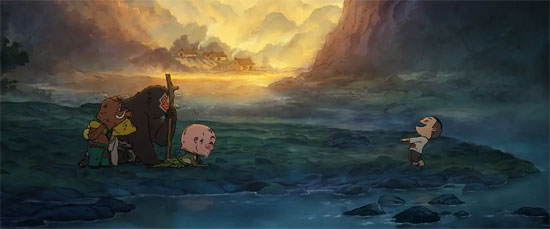
During this period, the Four Little Demons couldn’t even manage to pull off the most basic scams, and their situation was worse than ever before… The turning point came in the form of an old monk willing to accommodate them.
This old monk, who lived alone in an empty temple, I believe was the most enlightened ordinary person in “Nobody.” Even after the four little demons had spruced up their appearance, he could still see through their true forms at a glance. Yet he was willing to play along with their charade, letting them feast to their hearts’ content and even gifting the toad demon a set of monk’s robes.
In these difficult times, with people’s hearts in turmoil, even the monks had no interest in chanting sutras. Yet here came four little demons disguised as monks, though their disguise was still crude, it was already better than many people. The old monk did not believe in the distinction between humans and demons; he only looked at whether all living beings had a connection with Buddhism and a kind heart. It was precisely because of this simple enlightenment that the four little demons’ “fake journey” finally got on the right track.
After gathering their equipment at Shuang Gou Dong, when they arrived at Bei Zhang Village, the four little demons’ goals had unknowingly shifted.
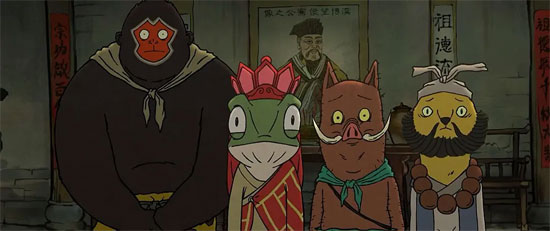
“Journeying to the West for the scriptures, seeking immortality” was their ultimate goal, but this grand vision was merely a pretext. Their actual short-term goal was to scam food and drink, yet they quickly expanded their ambitions to “upholding justice, subduing demons, and eliminating evil.”
This is a classic example of how, after physiological and safety needs are met, one begins to pursue belonging and respect. After narrowly defeating the white-haired rat demon, their advanced desires were greatly satisfied.
These changes also show that the pig demons who left Langlang Mountain did not truly know what they wanted; they simply began to pursue more after encountering a larger world on their journey.
The plot entering Xiaoleiyin Temple in the latter half is the turning point where “what is meant to happen will happen.”
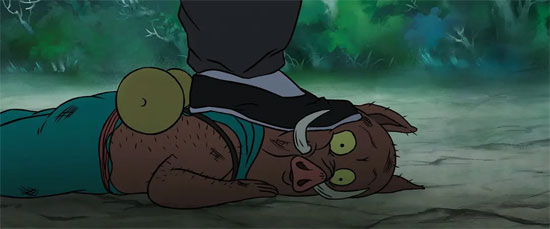
Although they were evenly matched in acting skills, the Four Little Demons were indeed far inferior to the Yellow-Browed King’s gang in terms of strength and rank. At the Small Thunder Temple, they finally realized how ridiculous their narrow-minded behavior had been.
First, they were unaware of the demons’ treacherous intentions and were manipulated into allowing Huang Mei to abduct the remaining young boys and girls from the village. Simultaneously, they were severely beaten by the leopard leader, realizing the vast gap between themselves and the great demons. Later, they were informed that Sun Wukong and the Buddha were acquainted, Tang Sanzang was the reincarnation of Jin Chan Zi, and Zhu Bajie and Sha Wujing were also demoted celestial generals. “Do you think anyone can go on the pilgrimage?” ” Cherish the opportunity to work under Huang Mei the Great Demon King.
The reactions of the four minor demons were also interesting: the impatient weasel demon felt that eating Tang Sanzang’s flesh deviated from their original goal and wanted to return to Langlang Mountain; the introverted ape demon kept muttering that he was the Monkey King and refused to comply; the pig demon initially accepted his fate but couldn’t resist saving the ape demon and then organized the former to rescue the children; the toad demon, who most desired to join the ranks of the great demons, initially wanted to settle down peacefully but ultimately succumbed to his brothers’ true nature.
In my view, rescuing the young boy and girl was the highlight of the four minor demons’ journey, but the subsequent battle with the Yellow-Browed King felt somewhat abrupt.
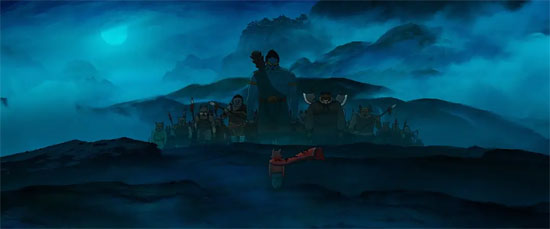
It’s not that this action sequence is bad (it’s clear that a lot of effort went into it, and the combined techniques are quite entertaining), but rather that the tone of “Nobody” leans more toward “the trivial matters of unknown individuals,” and suddenly giving them such a prominent role feels out of place.
Specifically, it’s like the “ultimate move” that the pig demon keeps mentioning. I always thought it would be a clever, practical, yet humorous trick, but it turns out it’s actually powerful. When the Four Little Demons combine, they can even hold their own against Huang Mei… though the cost of the ultimate move is depleting all their meager magical power.
Fortunately, the film handles the conclusion of the battle and the ending well. Huang Mei can’t figure out what they’re fighting for, while the pig demon and his friends clarify that they want to “live as they choose.” At this point, they’ve transcended the need for respect and love, reaching a state of self-realization.
Additionally, even when the four little demons gave it their all, they didn’t truly defeat Huang Mei (they only managed to stun him for an extended period). When Maitreya Buddha appeared, Huang Mei not only sprang back to life but also obtained the golden gong and the bag of human seeds, preparing to ramp up the difficulty for the real Tang Monk and his disciples in their next trial…
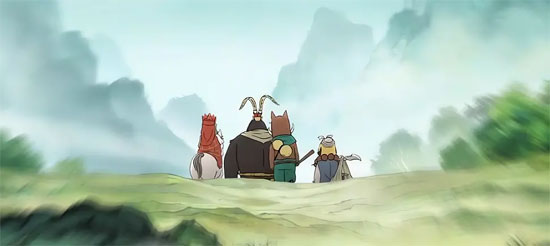
Don’t say that the pilgrimage team is made up of connected individuals, or that the pilgrimage itself is a script arranged by higher-ups. But does that prove that the Four Little Demons’ brief impersonation journey was meaningless?
From the very beginning, they could never reach Mount Ling and obtain the true scriptures. But from the moment they left Langlang Mountain and bravely set off on their western journey, they were already winners.
If one must speak of meaning, the villagers at the foot of Xiaoleiyin Temple erecting a small shrine for the four demons and lighting an incense burner for them is the best evidence. In my eyes, this is more precious than the four lifesaving hairs given by Sun Wukong.
Please specify:Anime Phone Cases » Nobody 浪浪山小妖怪 2025 Film Review: Not that great, but definitely worth a look.